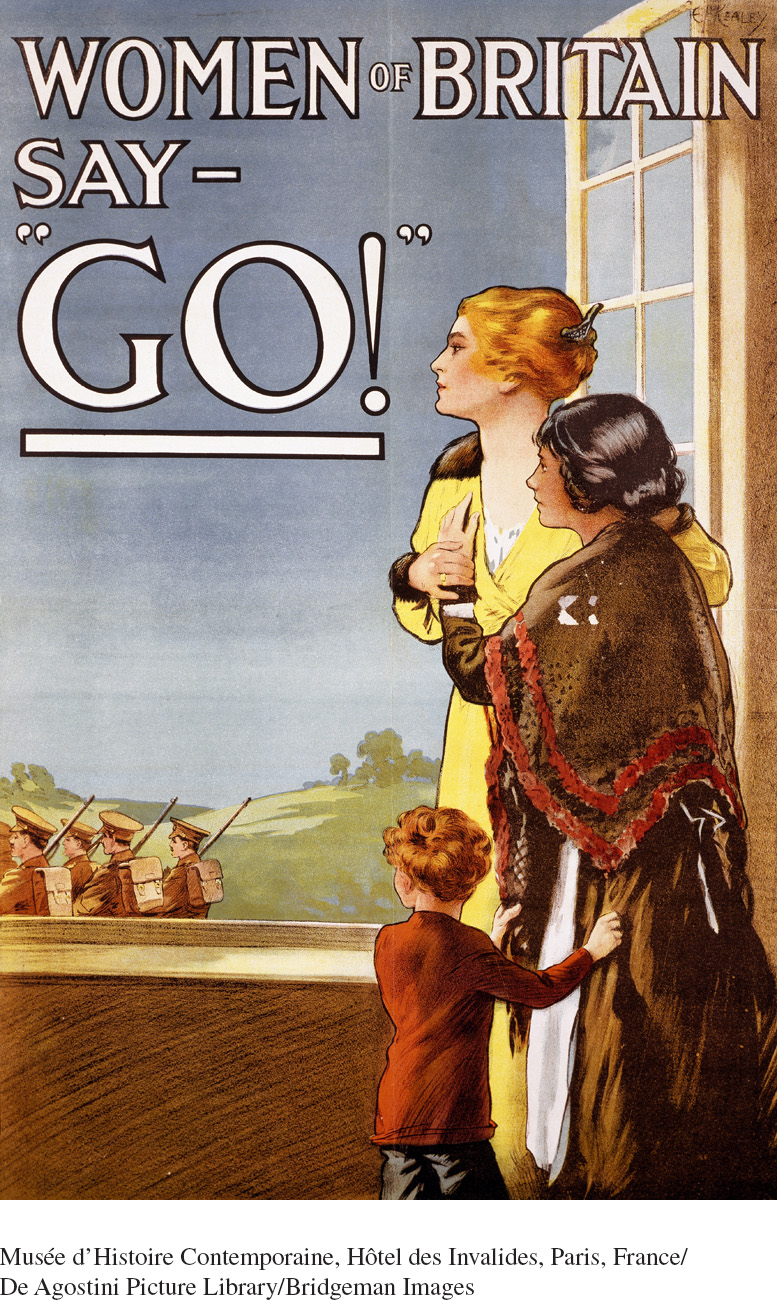Sources 20.2: On the Home Front
The First World War is often described as an early example of “total war” in which the civilian population was both mobilized for the struggle and deeply affected by it. With so many men away from home, women were engaged with the war in any number of ways. Tens of thousands joined the military in support roles, particularly nursing, while in Russia several “women’s battalions,” all-
Source 20.2A, a British propaganda poster from 1915, and Source 20.2B, a popular British song, both speak to the moral expectation for women in wartime. Source 20.2C, from Germany, reflects a common experience of women during the war — work in military-
Questions to consider as you examine the sources:
- For what purposes did male authorities seek to mobilize women during the war?
- What is the message of the British propaganda poster in Source 20.2A to British men? And to British women?
- How is the relationship between social classes in wartime described or implied in Sources 20.2C and 20.2D?
Source 20.2A
Women of Britain Say –– “Go!,” 1915

Source 20.2B
Keep the Home Fires Burning, 1915
They were summoned from the hillside, / They were called in from the glen,
And the country found them ready / At the stirring call for men.
Let no tears add to their hardships / As the soldiers pass along,
And although your heart is breaking, / Make it sing this cheery song:
Keep the Home Fires Burning, / While your hearts are yearning.
Though your lads are far away / They dream of home.
There's a silver lining / Through the dark clouds shining,
Turn the dark cloud inside out / Till the boys come home.
Source: Lena Guilbert Ford, “Keep the Home Fires Burning,” music by Ivor Novello (London: Ascherberg Hopewood and the Crew, 1915).
Source 20.2C
Editha von Krell
Recollections of Four Months Working in a German Munitions Factory, 1917
As the war went on, [the government] ordered two large munitions factories to be built right next to our town too. But very soon there was a shortage of male workers there. And so at the end of April 1917, all the town’s women and girls were asked to come and work in these factories. . . .
We began with an eight-
We were not allowed to air the rooms, even during our meal breaks. Doors and windows had to be kept shut because of the danger of explosions. But we prided ourselves on never slacking, on always keeping up with the professional workers. Here too the harmonious relationships we enjoyed with them was clear. For if ever this completely unaccustomed work proved too much for one of us [the educated women], one of the workers would help out as a matter of course, smiling, “Leave that to me, miss — it’s far too hard for you.”
Even today we still like to think back to the time when we were able to serve the Fatherland, working with our hands at one with the people.
Source: Deutsche Frauen, Deutsche Treue [German Women, German and Loyal], published in 1935. Reprinted in Joyce Marlow, ed., The Virago Book of Women and the Great War (London: Virago, 1998), 255–
Source 20.2D
Berlin Police Reports, 1915
On the 16th of the month at 5:00 PM thousands of women and children gathered at the municipal market hall . . . to buy a few pounds of potatoes. As the sale commenced, everyone stormed the market stands. The police, who were trying to keep order, were simply overrun and were powerless against the onslaught. A life-
I . . . came upon a crowd of several thousand men and women who were howling loudly and pushing the policemen aside. . . .
Source: Brandenburgisches Landeshauptarchiv, Potsdam, Provinz Brandenburg, Repositur 30, Berlin C, Titel 95, Polizeipräsidium, Nrs. 15809, 15814, 15821, 15851. Contributed, translated, and introduced by Belinda Davis in Lives and Voices: Sources in European Women's History, edited by Lisa DiCaprio and Merry E. Wiesner (Boston: Wadsworth Publishing, 2000), 426–